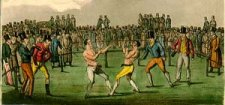Posts Tagged ‘History of the Ring’
Boxers of Yesteryear: Female Pugilists 1872
Illustrated Police News 13 April 2024
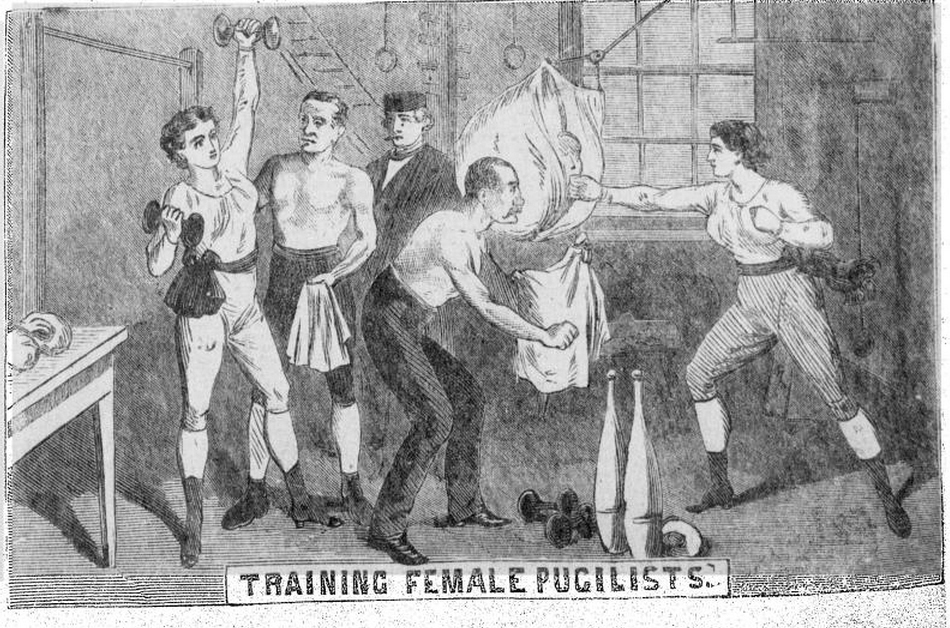
Our American Cousins are rather ingenious in inventing new sensations. The last novelty is a match made between two female competitors for fistic honours in the prize ring. The ladies are at present undergoing a rigid course of training.
In the morning at six o’ clock they get up and drink a cup of tea, and eat a piece of brown bread; then get on their bloomer costumes, heavy-soled shoes, and dog-trot with their trainer for five miles. They then bathe, and are rubbed down in the most approved style, and permitted to rest in bed one hour.
At nine o’ clock they breakfast, usually on mutton chops, brown bread, baked potatoes and coffee. No butter is allowed them. At eleven they drink a glass of porter, and then go sparring or striking the sand-bags. This exercise lasts about thirty minutes, when the trainer steps up and they have two hours of boxing. Then a bath and the usual rubbing down, and then their dinner, which is pretty well the same as breakfast, a beefsteak or mutton chop, potatoes, or coffee.
Then a rest of thirty minutes and then a walk or dog-trot with their trainer of a mile and repeat. Then a half-hour’s exercise with the sand-bags – that is, striking from the shoulder a bag of sand suspended about the height of their breasts, and weighing 175 pounds. This, we believe, is done to harden their fists, or “flukes” as the trainer calls them. After this exercise a cup of tea without the lacteal fluid or saccharine matter, and a piece of dry toast is given them for supper.
The evening, until about 8.30, when they retire punctually to rest, is spent talking over the approaching fight, making small bets on who gets the first blood and the feminine who goes first to grass.
Illustrated Police News 13 April 2024
Information
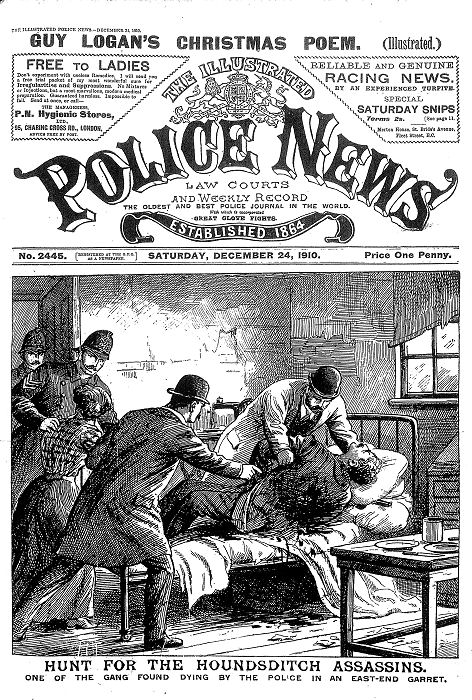 The Illustrated Police News was a weekly illustrated newspaper which was one of the earliest British tabloids. It featured sensational and melodramatic reports and illustrations of murders and hangings and was a direct descendant of the execution broadsheets of the 18th century.
The Illustrated Police News was a weekly illustrated newspaper which was one of the earliest British tabloids. It featured sensational and melodramatic reports and illustrations of murders and hangings and was a direct descendant of the execution broadsheets of the 18th century.
First published in 1864, and founded by George Purkess, who was a London publisher who already specialised in the publication of cheap “true stories” of crime, accidents and domestic disaster.
The Illustrated Police News ended publication in 1938. It was inspired by The Illustrated London News which had been launched in 1842 and revealed that newspapers with illustrations could achieve very high sales.
Its standards of illustration and tone were reminiscent of the old Newgate Calendar and the popular “Penny dreadfuls”, and it gained a reputation for sensationalism during the Jack the Ripper murders of 1888.
By 1897, the topics covered also diversified. Previously news unrelated to disaster had filled no more than a single column, but new popular items were now published. These included sporting news, with as much as a whole page devoted to boxing in almost every issue.
Around the turn of the 20th century The Illustrated Police News ran numerous articles dealing with the “alien immigration question” that promoted xenophobic attitudes and paranoia amongs its mostly working-class readership.
Boxers Of Yesteryear: James Figg
James Figg was born to a poor farming family in Thame, Oxfordshire, England in 1684 (or 1695, depending on the source) to Francis and Elizabeth Figg. He was the youngest of seven children and grew up tough, going to local fairs and challenging the prize fighters in the booths there. By the time he was a grown man he was 6 feet tall and around 185lbs, fit and fast, and travelled to fairs throughout the Midlands where he challenged all-comers from noon until sundown. He taught himself to fight with a short-sword, a staff and a club, and staged exhibitions of his skill at the fairs.
“Here I am Jemmy Figg from Thame, I will fight any man in England”. Figg was the first recognised champion of England at fighting with bare fists. Also an expert at wrestling, swordplay, and fighting with cudgels, he became prominent as a pugilist about 1719 and claimed the title ‘Champion of England’ from then until 1730.
Figg went on to become the first recognised British bare fist boxing champion and had become well versed in both armed and unarmed combat. History tells us that it was the Earl of Peterborough who first spotted Figg’s potential after witnessing him giving a demonstration of boxing, fencing and the use of the quarter-staff on the village green.
The Earl took Figg down to London where he would fight all comers, teach his fighting methods and give demonstrations of his skills. Figg became a popular figure and many people wished to learn from him and watch him fight. In 1719, Figg opened a boxing academy, which held over 1000 people, where he and his students would teach and demonstrate their skills. Figg’s business card for his academy declared him to be, “Master of the noble science of defence.” Figg lost only one fight and was considered to be the champion of Great Britain when he retired in 1730.
As Figg’s reputation grew, more and more “gentleman amateurs” took up boxing as a pastime and sought out Figg’s tuition. One of Figg’s students was a ‘Captain Godfrey’ who wrote,
“I have purchased my knowledge with many a broken head, and bruises in every part of me.”
This statement emphasises the realistic, and sometimes harsh, nature of Figg’s tuition. Figg also drew upon his extensive knowledge of fencing. The parries & ripostes of fencing had a large influence upon what became parries & counter-punches of modern boxing.
By 1720, he was openly acknowledged as London’s champion, and fought for money regularly, with the matches being advertised in the newspapers. There were three rounds in an organized prize-fight and it was also pretty brutal, with the bare-knuckle fight allowing slapping, kicking, biting and gouging.
Sometime before 1723, Figg let his Amphitheatre to another boxing master (It closed in 1743).and began to prize-fight on a regular basis at ‘The Boarded House’ behind Oxford Street, in Marylebone-Fields. It was not only men who fought there, but women and animals. Figg fought about once a month, and his opponents included Christopher Clarkson The Lancashire Soldier, Philip MacDonald The Dublin Carpenter, James Stokes Citizen of London (and husband of the famous lady-boxer Elizabeth Stokes). His most talented pupil, Jack Broughton continued to run his school and was instrumental in setting the first rules of boxing in 1743.
It should be noted, that this earliest form of modern boxing was very different. Contests in Figg’s time, in addition to fistfighting, also contained fencing and cudgeling. Although hitting with fists was emphasised, a boxer could grapple and throw his opponent and then either hit him when he was down, or continue to grapple whilst on the ground. Indeed, it was not until 1743 - 13 years after Figg’s retirement - that kicking an opponent whilst he was down (“purring” as it was called at the time) and gouging were banned from the ‘sport’.
On the 6th of June 1727, James Figg fought with Ned Sutton - a pipe maker from Gravesend. The bout generated huge interest and amongst the audience were many important names of the time, including Sir Robert Walpole - the Prime Minister.
The first match was to be with swords! Which goes to illustrate that the use of weapons were also part of a boxer’s training. The first thirty minutes of the bout were fairly uneventful until Sutton went on the attack, which resulted in Figg cutting his arm on his own sword. Under the rules this did not count, and hence the bout continued. It was in the sixth round that Figg cut Sutton’s shoulder, which resulted in Figg being granted the first victory.
After a thirty-minute interval, the “Fist-Fighting” began. After eight minutes Sutton executed a throw which resulted in Figg being dumped at the umpire’s feet. Figg immediately regained his feet and went onto to throw Sutton such that he required time to recover as the result of the bad and heavy landing. When the bout continued, Sutton landed a blow that was so powerful that Figg was knocked clean off the stage (ropes were not used at the time) and into the audience. Figg recovered and went onto punch Sutton to the floor, where he then grappled Sutton into submission.
The final bout was with Cudgels, during which Figg broke Sutton’s knee and hence secured a three-nil victory. The description of Figg vs. Sutton bout shows how grappling, groundwork and weapons skills were as much a part of boxing as the punching for which the art is so revered today.
James Figg was 40 when he died (or around 50 depending on source of date of birth) and left a wife and many children, one of his grandsons also became a Boxing Champion some years later.
Figg may be regarded as the first boxing champion, but he was also the first boxing coach, manager and promoter. He also established an Boxing Ring at Oxford Circus which set the pattern for boxing as we know it today.
A ring was put in place with ropes around the sides and the floor was raised so the spectators could see the fight. This pit the sport onto a professional basis and anyone who had aspirations to become a boxer would show up at the Oxford Circus Amphitheatre as a participant or a spectator.
December, 1734 this notice appeared in the newspapers: He is buried at St Marylebone cemetery in Finchley, north London.
Last Saturday there was a Trial of Skill between the unconquered Hero, Death, on the one side and till then the unconquered Hero Mr James Figg, the famous Prize-Fighter and Master of the Noble Science of Defence on the other: The Battle was most obstinately fought on both sides, but at last the former obtained an Entire Victory and the latter tho’ he was obliged to submit to a Superior Foe yet fearless and with Disdain he retired and that Evening expired at his house in Oxford Road.
Figg was inducted into the Ring Boxing Hall of Fame in 1954 and the International Boxing Hall of Fame in 1992
Known Record of James Figg - the common belief is that Figg had a record of 269-1 in 270 fights. His only loss came when Ned Sutton beat him to claim the title. Figg demanded a rematch, which he won, and also went on to retire Sutton in a rubber match.
1719 - Sep 18 -Figg claimed the Championship of England and opened an amphitheatre on Oxford Road in London, England.
1720-1723 vs Timothy Buck in London, England -Won - Championship of England
vs Tom Stokes in London, England – Won - Championship of England
vs Bill Flanders in London, England - Won -Championship of England
vs Chris Clarkson in London, England - Won -Championship of England
1724 vs Ned Sutton in Gravesend, England - Lost -Some sources report Championship of England
1725 - May 31 vs Ned Sutton in London, England – Won -Some sources report Championship of England
1727
May 23 Ned Sutton - London, England
May 30 Ned Sutton - London, England
June 06 Ned Sutton - London, England - Won Championship of England
1730 -Figg announced his retirement from the ring and
relinquished the Championship of England – Handed title over to George Taylor
1733 - May 6 Jack Broughton claimed title.
Boxing News Blog & Malta Boxing News
Boxing News Blog & Malta Boxing News
‘Boxing News’ dedicated to deliver the latest news from the world of combat sport. Regular daily updates for Pro Boxing, WSB Boxing, Olympic Boxing, Kickboxing, Thai Boxing, MMA and other Combat Sports.
A series of historical and biographical articles exploring the rich history of boxing and honoring the great pugilists of yesteryear.
Boxing Schedules and Result Archives
Malta Boxing News: Always with you @ your service all the year round
Boxers of Yesteryear: Ernie Terrell
Ernie Terrell will always be considered as the second best heavyweight of Ali’s first reign
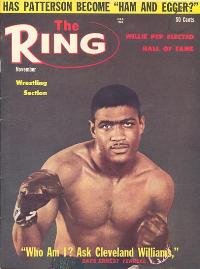 Ernie Terrell came along at a time that couldn’t have been worse from a legacy point of view. This tall heavyweight boxer with the long left jab and frustrating, effective but not crowd-pleasing style will forever be destined to struggle in the shadow of Muhammad Ali’s reign.
Ernie Terrell came along at a time that couldn’t have been worse from a legacy point of view. This tall heavyweight boxer with the long left jab and frustrating, effective but not crowd-pleasing style will forever be destined to struggle in the shadow of Muhammad Ali’s reign.
Terrell was born April 4, 1939, in Belzoni, Miss., but he is associated to this day with his adopted hometown of Chicago. The 6-foot-6 pugilist and singer posted a 46-9 record from 1957-73 and, in his prime, was a promiment figure in the heavyweight division. He held the World Boxing Association title from March of 1965, when he decisioned Eddie Machen in 15 rounds, to February of 1967, when he lost a 15-round decision to Muhammad Ali in an infamous unification bout remembered for Ali’s ceaseless taunting of Terrell. During his career Ernie defeated such opposition as Zora Folley, Cleveland Williams, George Chuvalo, Eddie Machen, Luis Faustino Pires, Robert Davila, Jose Luis Garcia, Bob Foster, Doug Jones, Frankie Daniels, Amos Lincoln and “Young” Jack Johnson.
Terrell has an outstanding amateur boxing background: In 1956: He made the final of the Chicago Golden Gloves Tournament of Champions at light heavyweight with James Boyd of Montgomery, AL, being awarded the verdict. In 1957 he won on the Chicago Golden Gloves Tournament of Champions at light heavyweight by KO in the 1st vs. Larry Vignaroli of Des Moines, IA, and won the Intercity Golden Gloves championship at light heavyweight vs. Eddie Bramlett.
Terrell was a strategist in the ring. He had 21 knockouts in his career, but he wasn’t known for the power in his punches. He was known instead for his intelligent, if cautious, manner and his befuddling jabbing-and-holding style wasn’t pretty but it was effective. Terrell attempted to get optimum use from the height and reach advantages that he usually enjoyed, with predictable results.
Terrell turned professional in 1957. He won eighteen of his first twenty contests losing two eight round split decisions to Johnny Gray. In 1960 he was outscored by the capable Wayne Bethea. In 1962 Ernie suffered a major set back when he was halted by the powerful Cleveland Williams.
Terrell began his march to the top in 1963 defeating Williams in a return match and top contender Zora Folley. In 1964 Big Ernie beat Gerhard Zech, Jefferson Davis and stopped a young Bob Foster. A knockout over Henry Wallitsch in October of 1964 in St. Louis gave Terrell 12 consecutive wins, a 37-3 overall record, and a spot among the top contenders vying for the crown now held by Clay.
 Terrell was near the top of the ladder in the heavyweight rankings when the World Boxing Association stripped Clay of the title. After Clay upset Sonny Liston in February of 1964 to win the crown, Clay quickly became persona non grata in the eyes of the WBA administration when he announced his alliance with a Muslim sect that embraced a doctrine which referred to white people as devils, was linked with protests and violence, and was perceived to be a dangerous threat to society. Clay, who had changed his name to Cassius X (prior to officially adopting the name Muhammad Ali), was unceremoniously dumped by the WBA. The official reason given was that Clay agreed to give Liston a rematch. The real reason was obvious; the WBA didn’t want anything to do with Clay.
Terrell was near the top of the ladder in the heavyweight rankings when the World Boxing Association stripped Clay of the title. After Clay upset Sonny Liston in February of 1964 to win the crown, Clay quickly became persona non grata in the eyes of the WBA administration when he announced his alliance with a Muslim sect that embraced a doctrine which referred to white people as devils, was linked with protests and violence, and was perceived to be a dangerous threat to society. Clay, who had changed his name to Cassius X (prior to officially adopting the name Muhammad Ali), was unceremoniously dumped by the WBA. The official reason given was that Clay agreed to give Liston a rematch. The real reason was obvious; the WBA didn’t want anything to do with Clay.
When the WBA stripped Ali of his title recognition they matched Terrell with contender Eddie Machen. It was an ugly fight with a lot of wrestling and little punching but Terrell did what he had to do to win the ” vacant ” title.
In November of 1965, Ali put his title (WBC) on the line against Floyd Patterson; Ali was beating everyone who beckoned for a title shot. After dispatching of Patterson, Ali repeated Terrell’s feat when he earned a decision over Chuvalo in Toronto. Ali then went overseas and posted victories in quick succession over Henry Cooper and Brian London in England, and over southpaw Karl Mildenberger in Germany. Ali returned home and knocked out Cleveland Williams, who was just a shell of his former self, in three rounds in Houston.
During his reign as WBA Champion, Terrell defended the title twice. Maybe Ernie was not considered the real champion but he did establish himself as the most formidable challenger to Ali. He closed 1965 with a decision over rugged George Chuvalo. In 1966 Terrell defeated slick Doug Jones. Finally after a failed attempt Terrell and Ali were finally matched to unify the title and end the confusion about who was the legitimate heavyweight champion.
The bout would take place in February of 1967 at the Houston Astrodome. Ernie’s bold refusal to acknowledge Ali’s Muslim name and refer to him as Clay irked Muhammad who vowed to punish Ernie.
What most people remember about the Ali-Terrell fight is Ali continually yelling “What’s my name?” as he pummeled and punished Terrell mercilessly.
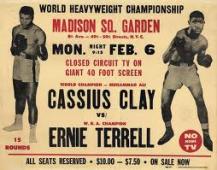 Ali worked Terrell over throughout the fifteen rounder. Round after round Ali would lash out at Terrell with punishing jabs and flurries. Terrell just didn’t have the means to neutralize Ali’s amazing hand speed. To Ernie’s credit he gamely absorbed the punishment with a very swollen eye. Many observers felt that the referee should have intervened and halted matters some time after the ninth round. The ref didn’t, though, and the massacre went on for a lopsided 15 round decision, with Ali reclaiming the undisputed Championship.
Ali worked Terrell over throughout the fifteen rounder. Round after round Ali would lash out at Terrell with punishing jabs and flurries. Terrell just didn’t have the means to neutralize Ali’s amazing hand speed. To Ernie’s credit he gamely absorbed the punishment with a very swollen eye. Many observers felt that the referee should have intervened and halted matters some time after the ninth round. The ref didn’t, though, and the massacre went on for a lopsided 15 round decision, with Ali reclaiming the undisputed Championship.
Terrell continued to box after losing to Ali, but he never fully recovered.
The WBA would later strip Ali of the title again in 1967 for refusing induction into the Armed Forces.
An eight man elimination tourney was set up to determine Ali’s successor. Ernie was one of the eight contestants and an early favorite to win the tournement. Terrell was eliminated in the first leg of the tourney being upset by Thad Spencer. Terrell looked to be finished when he next lost to Mexican Manuel Ramos. He would not fight again until 1970 and his comeback drew little interest until he scored a major upset in 1972 by halting highly rated Jose Luis Garcia. In 1973 Ernie lost a very controversial verdict to Chuck Wepner but his career then came crashing down when he was belted out in one round by Jeff ” Candy Slim ” Merritt.
In reality Ernie Terrell was a viable contender who was simply overshadowed by “The Greatest”.
In 55 professional fights, Terrell earned a record of 46 wins (21 by knockout), nine losses and no draws. He retired from boxing in 1973 and began a career as a music producer in Chicago, Illinois.
Ernie Terrell ran unsuccessfully for alderman of Chicago’s 34th ward in 1987. He finished second in the primary but lost to Lemuel Austin in a runoff.
Terrell is the older brother of The Supremes’ early 1970s lead singer Jean Terrell. In the 1960s, she sang with his group, “Ernie Terrell & the Heavyweights”.
Sources: Britannica, Mike Dunne (Historian), Cyberzone, Wikipedia and Eastside Boxing.
.
History of the ring series
.
Boxers of Yesteryear
‘Boxing News’ dedicated to deliver the latest news from the world of combat sport. Regular daily updates for Pro Boxing, WSB Boxing, Olympic Boxing, Kickboxing, Thai Boxing, MMA and other Combat Sports.
Boxers of Yesteryear
click link above to go to archives
A series of historical and biographical articles exploring the rich history of boxing and honoring the great pugilists of yesteryear.




